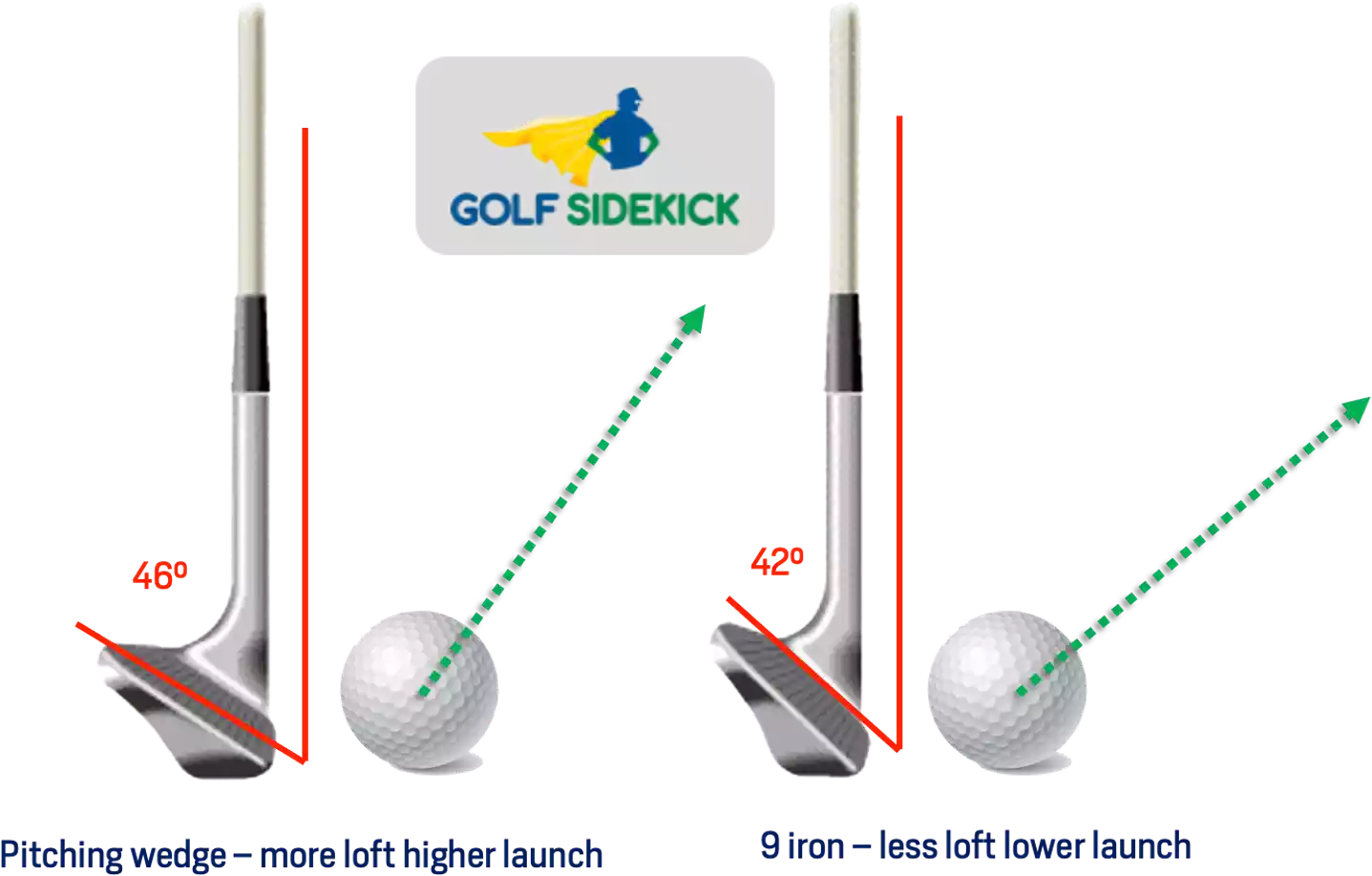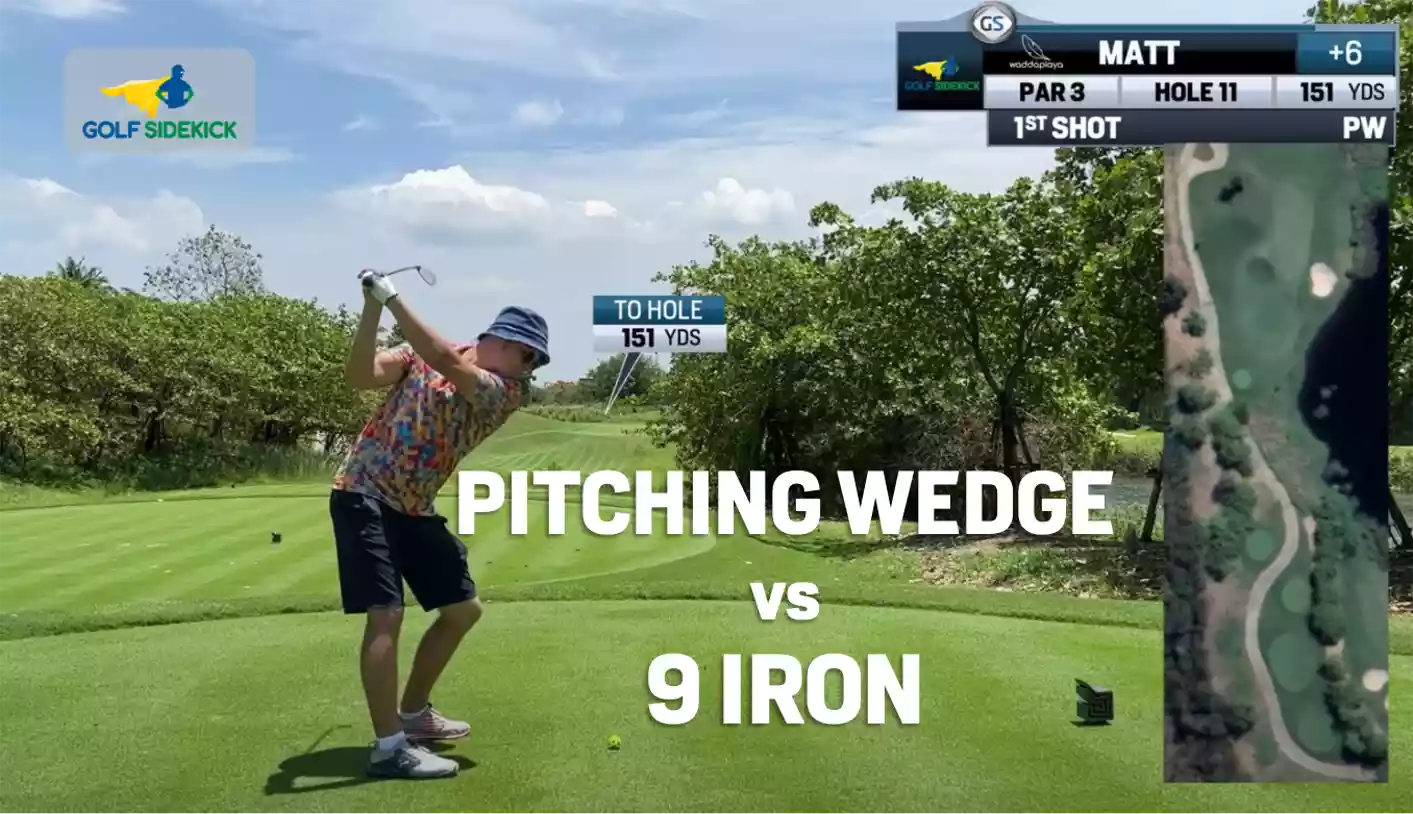Last Updated on December 26, 2023 by Matt Greene
Both the 9 iron and the pitching wedge are important scoring clubs for all golfers. How do we know which to use for which situation on the course? The key difference between a 9 iron and a pitching wedge is that the 9 iron has less loft than the pitching wedge. What does it mean for your game? I'll explain with examples below.
These important clubs can be used for many different shots and situations, from full swings to chip shots and pitches. In this guide I will go through all of the ways you can use the 9 iron vs the pitching wedge and help you max out your skill level with these scoring clubs.
This is what we'll cover:
- What makes a 9 iron and pitching wedge different?
- When to use a 9 iron vs pitching wedge - shot selection
- What is the ideal shot shape?
9 iron vs pitching wedge what is the difference?
For most golfers, the 9 iron and pitching wedge will come as part of a set of irons and will look very similar. A more experienced golfer may choose to carry a specialist pitching wedge which matches their other wedges.
A modern 9 iron will be around 36 inches long and have a club face loft somewhere between 41 and 44 degrees. A modern pitching wedge with be a fraction shorter, around 35.75 inches and have a loft of between 45 and 48 degrees.
Key differences
The 9 iron in your golf bag will have around 4 degrees less loft than your 9 pitching wedge. As one of the golf wedges, the pitching wedge is a scoring club and will be used a lot around the greens. It will be used in different ways to your sand wedge and lob wedge and will have a lower trajectory.
Your 9 iron is classed as a short iron and will be mostly used for approach shots into the green.
It's vital that you get the gaps between these clubs right so that you don't have a bunch in your distances. Check the specs of your iron set and learn how far these clubs carry with a full swing and in other situations.

What degree is a 9-iron
The average loft of a 9-iron sits between 40 and 43 degrees but golf brands releasing irons with strengthened lofts of lower degrees.
One such club is the Callaway Mavrik Men’s 9-iron at 36 degrees. That is about the same as an old-school 7 iron loft.
What degree is a pitching wedge? (Pitching wedge loft)
A typical pitching wedge today features 45 to 48 degrees of loft.
The minimum loft you will find on a pitching wedge is 43 degrees. Tiger Woods is rumored to have a pitching wedge with 50 degrees of loft!
When to use a 9 iron or pitching wedge - shot selection

Now that we've covered the basic differences between these two golf clubs, lets look at some scenarios when you would use each specific club.
Most golfers will be using these clubs from within 150 yards of the hole. That means that with a full swing with average swing speeds, they will be hitting their 9 irons between 125-150 yards and their pitching wedge 100-125 yards. Both the pitching wedge and 9 iron can be used for short distances and chip shots by employing the "bump and run" technique.
9 iron example
You are 125 yards from the hole. The green is slightly above you and you have the wind blowing into your face. The pin location is on the front of the putting surface with nor trouble behind. For this approach shot you would normally hit a full pitching wedge, but in these conditions you will need a lower trajectory and more distance. The 9 iron is the better choice here as it will guarantee enough distance without creating spin which will call the golf ball to balloon and come up short.
Don't get caught in an ego trap, and think you have to hit the shortest club possible for every yardage. Yes professional golfers like Phil Mickelson and Tiger Woods might be able to hit a 9 iron 160 yards, but do you know what conditions they are playing in? Ignore the PGA Tour hype!
Pitching wedge example
You have 110 to the hole from the fairway. The lie is perfect but the greens are hard. You need the extra loft of your pitching wedge to get the golf ball close to the flagstick. If you were to hit a softer 9 iron, the long angle would be too low and you might end up with the ball rolling off the green.
You could hit a full sand wedge, but there is the risk of a thin shot as you try to generate more distance. A gap wedge (50-52 degrees) could also be used in this situation.
Pitching and chip shots
Many people will choose to hit a chip shot with their 9 iron or pitching wedge. I frequently turn to these clubs for a simple bump and run around the greens where you may have just missed the green and are on the fringe, approach or in the rough.
Making a more rigid putting style stroke with one of these clubs sends the ball slightly in the air, but gets it rolling quickly It helps eliminate a lot of issues you can get with a lofted club and is a great shot to add to your short game.
What is the ideal shot shape?
Do you have a specific ball flight tendency with your short irons? With anything less than an 8 irons, my stock shot is a pretty straight flight which I find works as the distances I'm hitting with my short irons doesn't require me to work the ball.
I find it more difficult to shape higher lofted clubs and find I have to really think about hitting a deliberate draw or fade.
I would advise you too stick with your standard shot shape with these clubs unless you feel it is causing you problems with accuracy and distance control.
Sometimes a fade will create more spin and less distance but it will usually cause the ball to fly higher which can be beneficial.
A draw can be very useful for windy conditions to try and keep the ball low while not not losing distance.
The best thing to do is find your stock shot and stick with it.
What if I don't have a stock shot?
Every golfer will have a stock shot with each golf club, the key difference is repeatability and consistency. Better players can hit the same or similar shot over and over again and have confidence in their swing. Beginner or high handicap golfers don't have this confidence or consistency in their swing but they can develop it with practice.
The stock shot I think many golfers have is the fade (left to right). There is nothing wrong with a fade and I think it is less damaging and more repeatable than a draw for high handicap players.
Get down to the driving range and pick a target which is within your usual 9 iron or pitching wedge range. Try to hit 20 -30 golf balls with the same shape at the target. If you hit a fade, set up left of the target and let the ball come back. You have to trust your stock shot shape to be able to use it out on the golf course and hit shots with confidence.
Understand stronger lofts
I say "modern" in the article because in older golf clubs, the lengths were shorter and lofts were higher. I had a set of Slazenger irons when I started golf nearly 20 years ago, and the loft of my 9 iron was 44 degrees and my pitching wedge was 48 degrees.
Golf club manufacturers have strengthened lofts in recent years as the desire to hit longer shots has overwhelmed the world. They do this by using technology in the irons to making golfers believe the new golf club in their hands is adding 5-10 yards to their game. it is true - but the reason is because the loft is less than before.
Where the modern irons especially for mid handicappers and irons for high handicappers really win, is that the lofts are indeed lower, but the ball flights are much higher than older irons. They engineer it so your 9 iron might go another 10 yards further with the stronger loft. But the flight of the ball is the same height as the older 9 iron which went 10 yards shorter!
I saw this recently with a friend of mine. He went to a big box golf store to try some new irons from one of the major OEMs. He couldn't believe that he was able to hit the ball 150 yard on the simulator with his 9 iron! Does it matter that the lofts are less? For most of the golfers in the world, definitely not! The irons have helped so many people enjoy golf more and more!
9 iron golf club distance
The average distance a male golfer will hit his 9 iron is 115 yards. For PGA Tour pros, its 159 yards.
Pitching wedge distance
The average distance a male golfer hits his pitching wedge is 100 yards. For PGA Tour pros, its 146 yards.
10 iron vs. Pitching wedge
A ten iron is the same thing as a pitching wedge. The two terms are interchangeable but you are less likely to see a 10 iron in a golf bag these days. PGA Tour player Mav McNealy has a 10 and 11 iron in his bag! He doesn't chip with his pitching wedge or gap wedge so wanted those clubs to be treated as normal irons. Whatever floats your boat I guess!
Conclusion
In this article we have shown the key differences between the 9 iron vs pitching wedge. What I want you to take away from this guide is that each club can have a specific purpose in your bag but it can also be used in many different and creative ways. Don't be too rigid in how you chose to use a pitching wedge or 9 iron out on the golf course and you will be limiting your opportunities to score.
